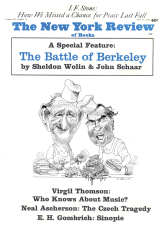In response to:
A Special Supplement: Reflections on Violence from the February 27, 1969 issue
To the Editors:
Hannah Arendt, in her “Reflections on Violence” in the February 27 issue of The New York Review, criticizes my comparing violent radical students to Luddite machine-smashers, and finds it “odd” that I show a “bias in favor of marching forward at any price,” and “even more odd” that I am unaware of the “decisive differences” between nineteenth-century and twentieth-century machinery, since the former was developed for production, and the latter for destruction, and in addition the rebels do not know where the contemporary machinery is located nor how it can be smashed.
Dr. Arendt has mistaken my position: there is nothing in it that reflects a bias in favor of “marching forward,” or for new technology as such. It is based on the reality that only the machines make possible the standards of living that the machine-smashers and almost all other people insist upon—for food, clothing, housing, travel, medical care, education, and for a wide degree of choice in all these matters—for the increasing numbers on earth. Nor do the distinctions Dr. Arendt has drawn between nineteenth-century and twentieth-century machinery hold up. In the nineteenth century too increases in the power to conduct war and apply violence were basic motives for much technological development, even for the development of mining, metal-manufacturing, tool-making, railroads and steamships, etc., Nor is it possible at this point to imagine that the catastrophic capacities for destruction of contemporary machines can be controlled except through other machines, technological and organizational. Finally, after destruction of the computer at Sir George Williams, with such simple tools as matches and axes, and the partial destruction of the catalogues of a number of major libraries (the library catalogue is also a rather recent machine, more of the twentieth-century than of the nineteenth-century), Dr. Arendt might agree that the violent student radicals do know where the machinery is located and how to destroy it.
Nathan Glazer
Graduate School of Education
Harvard University
This Issue
June 19, 1969



